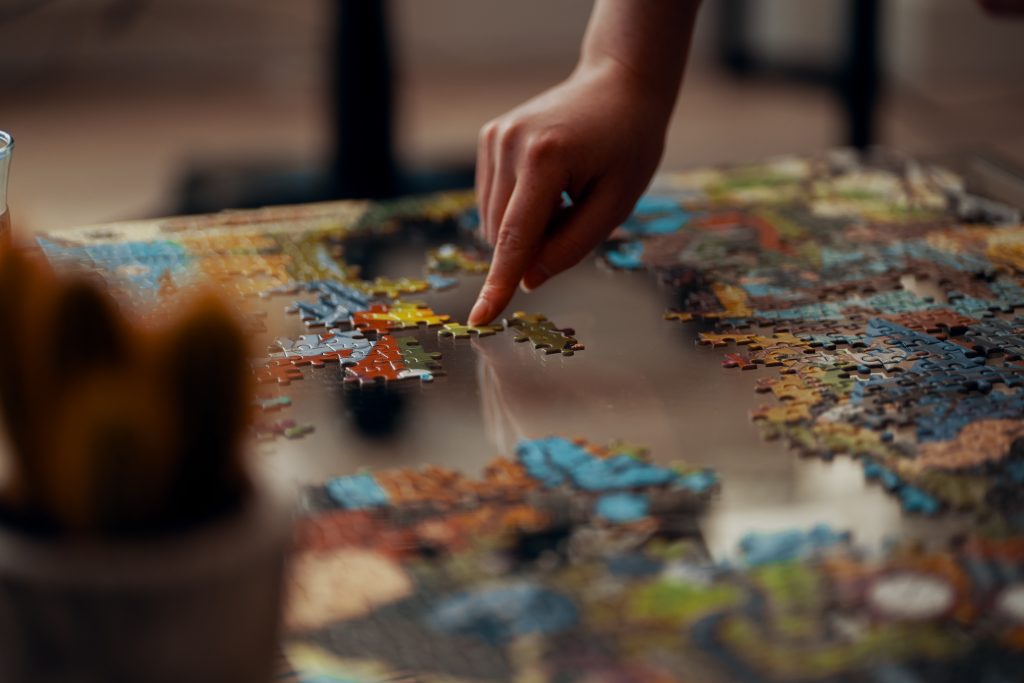This page contains affiliate links
Sometimes, it’s useful to have a change from coloring in. As they say, a change is as good as a rest. Coloring can encourage focus and calming states but we also need a different kind of challenge, as a change.
Jigsaw Puzzles
 Jigsaw puzzles can be fascinating and not just for children. Even for adults, there is a thrill in managing to combine hundreds or even a thousand or 1500 small pieces to recreate a beautiful composition; and the more difficult the puzzle, the better the thrill of beating the challenge. Small children may start out with wooden pieces that each fit into their own space on a tray. The pieces often have a handle for ease of moving them. As they get older, so the puzzles contain more pieces and each one is smaller. These are often made from thick card to combine toughness with light weight, so the puzzles can be done again at a later date. Some puzzles are designed for display as a complete picture, once completed.
Jigsaw puzzles can be fascinating and not just for children. Even for adults, there is a thrill in managing to combine hundreds or even a thousand or 1500 small pieces to recreate a beautiful composition; and the more difficult the puzzle, the better the thrill of beating the challenge. Small children may start out with wooden pieces that each fit into their own space on a tray. The pieces often have a handle for ease of moving them. As they get older, so the puzzles contain more pieces and each one is smaller. These are often made from thick card to combine toughness with light weight, so the puzzles can be done again at a later date. Some puzzles are designed for display as a complete picture, once completed.
3D Puzzles
It’s even possible to obtain 3-D jigsaw puzzles, so that a model is created, rather than a flat picture. These can be of wood, card or even plastic.
Benefits Of Jigsaw Puzzles
Playing with jigsaw puzzles can improve hand / eye co-ordination, color and pattern recognition and improve fine muscle movement, as well as improving reasoning and problem solving abilities. They can also provide a calming influence and promote the ability to focus. Some older people find jigsaw puzzles very attractive if they are recuperating from illness or need to rest.
Using jigsaw puzzles can be educational, however, just “doing” a jigsaw puzzle, even one with educational content, will not necessarily improve the educational ability of the one completing it. A jigsaw puzzle of a map or a series of animals or of a painting by a famous old master, will not improve knowledge of these unless the information is studied, as well as the puzzle completed. So, you could extend your pleasure and use of the puzzle, by choosing one on a subject you would like to learn more about. Completing the puzzle will help you recognise the different components and help provide the motivation to find out more.
Jigsaw puzzles are a kind of “hands-on” learning and can be very attractive to kinaesthetic learners, that is, those who learn best through “doing” or through bodily movement of some kind.
With bigger jigsaw puzzles, it may take time to complete these: not everyone can complete a big puzzle in an afternoon, nor does everyone have space to keep a puzzle sitting out, so you may want to consider getting a puzzle mat for holding the puzzle as you do it and which allows it to be rolled up and put away without falling apart. Then, when you are ready to work at it again, you bring out the mat, unroll it and the jigsaw puzzle is ready for more work to be carried out on it. As an alternative, you can keep parts of the puzzle in different flat boxes, completing one section of the puzzle at a time, putting them together only near the end.
Marquetry
Marquetry is a form of woodwork, where a space is made in a piece of wood and the space is inlaid or filled with a differently colored wood or even other material. This is a totally different hobby from jigsaws, yet there is a similarity, in that shapes must be filled with the correct piece of wood (or other material) in order to complete a pattern or a picture. This type of craft is done once only, as the inlaid piece of wood is glued in place and the furniture so decorated is displayed or used.
Mind Puzzles
Rather than jigsaw puzzles, you could also try brain teasers, physical puzzles made of wood or metal, where you have to take them apart, then put back together again. Some of these are versions of tangrams or a physical version of the old tetris games. Others are like lock and keys or secret drawers. Many are termed “stocking stuffers”, budget priced games that fit into a small space. They can be carried in pockets or bags and are good to while away the time if sitting and waiting. Some offices keep these kinds of toys in reception rooms to keep clients or patients amused while waiting to be seen.
